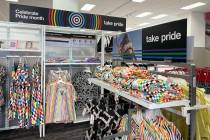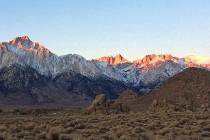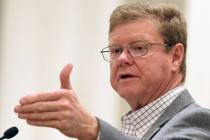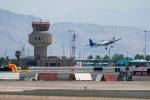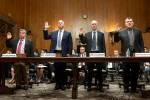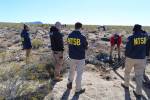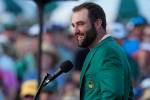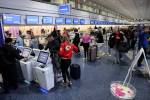Bob Hausler
Not counting annual visits by Santa Claus, the first aircraft to land in Las Vegas touched down on the afternoon of May 7, 1920.
Matter of fact, that flight had a lot in common with those of the jolly old elf. Jake Beckley was the surrogate Santa in this tale, his sled an old Curtiss "Jenny" Biplane. The part of his reindeer was played by Blythe, Calif., newspaper editor Randall Henderson, a pilot in the Army Reserve.
Dropping to 500 feet, Henderson made a wide banking turn over the tiny town of Las Vegas, then came in low and slow over the home of Jake's brother, Will, at 120 S. Fourth St. Jake peered over the side of the open cockpit, spotted the green square of lawn, and dropped a doll for his niece, Virginia. The Beckley brothers were pioneer retailers, and owned stores in Las Vegas and Blythe.
Henderson then pointed the machine south, and looked for the plot of naked dirt that was Anderson Field, named for property owner Harry Anderson, and located near what is now the corner of Paradise Road and Sahara Avenue.
The arrival did not go unnoticed by the local citizenry. Their reaction was akin to what might happen today if the space shuttle were to make an unannounced landing on the Strip. Businessmen locked their shops, housewives shed their aprons and donned their newest hats, and barefoot kids bolted, followed by a riot of barking dogs. All were off to see the wondrous flying machine. So enthralled was the crowd that Henderson spent that day, and then three more, taking passengers aloft in the wood-and-canvas craft.
"Las Vegas has at last experienced the joy of flying, at least some of Las Vegas has," wrote C.P. Squires in The Las Vegas Age. "All the rest of us are taking treatment for dislocated necks and sunburned tonsils."
No one was experiencing the joy of flying that day more than Bob Hausler, a young mechanic who had worked in the railroad shops since the previous year. Like aspiring actors who grudgingly wait tables, Hausler was biding his time until he could find a way to make a living in the aviation business.
As an Army aviator, Hausler had in 1918 piloted one of five planes that had flown from Los Angeles to Salt Lake City -- passing near Las Vegas -- then on to Reno and Sacramento, Calif. The mission of the squadron was to scout potential airmail routes. Hausler believed that the Los Angeles to Salt Lake City route was superior to the one from Salt Lake to Sacramento. The latter required fliers to cross the Sierra Nevada range west of Reno, and to negotiate the perilous 7,329-foot Donner Pass. The southern route over the Mojave was much lower, with mountain passes only half as high, and much less prone to blizzards.
Hausler had scraped out a very rough landing field in 1919, anticipating an air exhibition that didn't happen. But Hausler was more concerned with creating a field that was up to the standards of the Aero Club of Southern California, the Aero Club of America and the U.S. military. If Las Vegas could establish itself as a modern facility, he reasoned, it might stand a chance of being included on the new airmail routes being established by the government. He also wanted to establish a flying school and aircraft service station. Unfortunately, the airmail route across Nevada bypassed Las Vegas in 1920, following instead the perilous northern route through Reno and over the Sierra.
But Hausler remained optimistic, and continued to make improvements to Anderson Field, leveling it, demolishing an old roadhouse on the land. By November of 1920, he had cleared, leveled and smoothed the field, constructed a small building and completed an L-shaped runway, which would allow pilots to land without regard for the direction of the wind. The field was now up to standard, and could be included in the aviation guidebooks published by the Aero Clubs. Las Vegas was on the aviation map, thanks to Hausler.
The years immediately following World War I are generally regarded by aviation historians as "The Barnstorming Years." The brave men who had flown combat missions over Europe in frail craft came home to find that there was little commercial market for their skills. The air freight industry had scarcely gotten off the ground and passenger air service was still many years away. But the public was fascinated with the romance of open skies, so aviators could earn their living as entertainers. Barnstormers wowed crowds with wing walking, parachute jumps and fancy aerobatics. There was no shortage of aircraft; surplus military models sold for almost nothing. And there was no shortage of people waiting to pay for a windblown foray into the wild blue yonder.
Fliers were still a small group, and rather close-knit. It was not unusual, when two airplanes passed each other in the sky, for one pilot to wag his wings, indicating he intended to land. The aviators would look around for a flat spot, land, swap gossip and exchange weather news. Knowing he could muster quite a few of his fellow throttle jockeys, Hausler proposed a full-blown air show on Thanksgiving Day to celebrate the completion of Anderson Field.
"The matter of an aviation meet in this city Thanksgiving Day was not undertaken with the expectation of any immediate profit," wrote Squires. "Mr. Robert Hausler, who is promoting the enterprise, is giving his own time and some of his money for the work. His object is to place Las Vegas on the air map, with a view to future business ... Another plan which Mr. Hausler hopes to realize, is the establishment of a flying school here."
On the afternoon of Turkey Day, three biplanes, one piloted by Hausler, set down at Anderson Field, and were immediately surrounded by most of the population of Las Vegas, hurrahing and waving flags. But the real star of that air show was a peculiar dwarf biplane emblazoned with a skull and crossbones, and bearing the legend "Poison: Dose, One Drop."
It was an experimental craft -- as most planes of that time were -- and was designed and owned by C.O. Prest, who had built it at Crawford Airplane Co. in Venice, Calif. Prest was a veteran airplane builder, having designed his first craft in 1909. Poison had a wingspan of 18 feet, was 14.5 feet long and weighed 500 pounds. Designed for short takeoffs, it could get airborne on only 100 feet of runway, and climbed at a rate of 1,400 feet per minute.
"Poison is some kid," opined Squires. "He is about the size of a good fat jitney (a small bus) but has a sassy look, all sleeked out in a new coat of red paint. Mr. Prest claims that Poison is a nice little thing to travel with, although inclined to be a little flighty and noisy."
The plane had been shipped to Las Vegas via rail because Prest was unsure of the plane's ceiling, and whether it could clear the mountains between Los Angeles and Las Vegas.
Poison was powered by a 7-cylinder, two-stroke, 50-horsepower rotary engine. Practically all modern vehicles are powered by four-stroke engines, allowing their parts to be lubricated by a reservoir of oil, while two-stroke engines require oil to be mixed with the gasoline. But in Poison's time, two strokes were used in nearly all aircraft because they were capable of higher revolutions per minute than a four-stroke engine of the same size, and could therefore spin a propeller faster.
All of which is related here to explain what next happened to Poison.
The crowd stood in breathless silence as Prest taxied the little plane into a headwind, then gave her full throttle. Poison roared, Prest pulled back on the stick, and the plane shot into the sky. At about 75 feet, however, the engine abruptly quit and the plane nosed down into the dirt. Amid screams and shouts, the crowd rushed toward the crash, expecting the worst.
But the drop of Poison didn't kill Prest. In fact, other than a case of the shakes, he was unharmed. As it turned out, the castor oil which was mixed with the plane's fuel was either contaminated or had not been mixed properly. The biplane wasn't seriously damaged, but Prest decided to he would dismantle it and use the parts to build a monoplane.
The airshow served the very important purpose of making the Las Vegas public aware of aviation, and its potential as an economic development tool. For the next decade, whenever an airplane landed in Las Vegas, it was front page news, even if the pilot was just stopping to stretch his legs. Editors in Las Vegas and elsewhere around the nation dutifully recorded each new speed "record" from one point to another, and took particular delight in reporting "firsts." This reached the zenith of silliness when a Los Angeles newspaper printed a detailed account of the first man to shave in an airplane.
As for Hausler, he had found his aviation career. In an era where no such occupation existed, Hausler had become an "airport expert." He went on to design airports in Victorville and Caliente, creating a chain of state-of-the-art fields between Los Angeles and Salt Lake City, certainly a factor in the later decision to establish an airmail route between those two cities.
However, try as he would, he could not make a financial success of his flight school and airplane repair enterprises at Anderson Field. In 1923, an advertisement in the Las Vegas Age identified him as the distributing agent for Perfection Pressure Cookers. By 1924, he had left Las Vegas for good.
He later was named field secretary for the Western Aero League, a position that entailed traveling around the West, exhorting various cities and towns to develop their own airports. His message was especially well-received in Arizona. In 1925, the Winslow Mail newspaper published a special edition to honor Hausler for his work in developing western aviation. The editor's introduction lauded Hausler's persistence and energy, and stated that the edition was "Dedicated to Bob Hausler, who should be called Bob Hustler."




















